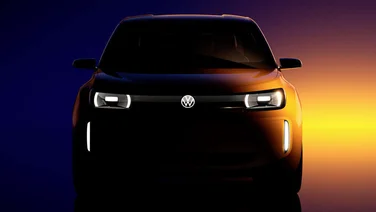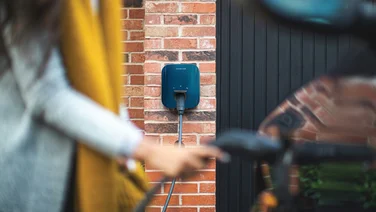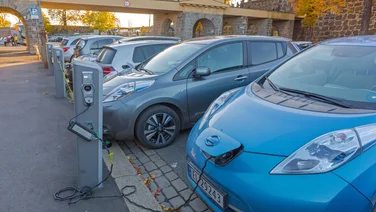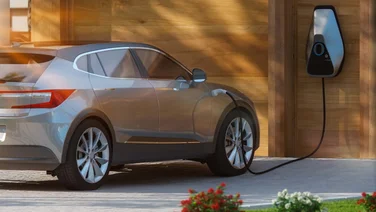Electric vehicles are taking over, and in May 2022 the UK government announced its intentions to let people drive their privately owned e-scooters on public roads. This is an amazing step forward, but can the lack of infrastructure in our cities support this revolutionary transition?

What is a battery swap station?
An innovative response to faulty electric vehicle charging stations, long charging times, and a lack of charging points, is the Gogoro Network in Taiwan. Essentially, drivers pay Gogoro a monthly subscription for the ability to use any of their battery banks without limit. When their electric scooters battery is low, they go to a bank, deposit their depleted battery into a charging point, and then withdraw a newly charged battery.
The simple process only takes a matter of seconds. Currently, GoStations only cater for two-wheel vehicles (mopeds, scooters, etc.) – probably because its so easy to change their batteries!
The popularity of battery swapping in Taiwan
The Gogoro Networks growth in Taiwan has been exponential. Launched in 2015, Gogoro now has over 2,277 battery swapping banks and this number is expected to overtake the number of gas stations in Taiwan (2,487) by the end of 2022.
The key to their success in Taiwan is driven by the accessibility of their battery banks. Pivotally, Gogoros batteries are not exclusive to their branded vehicles. Instead, Gogoro has partnered up with two-wheel manufacturing giants like Yamaha, Aeon Motor, and Motive Power Industry, in whats called the Powered By Gogoro Network (PBGN), in order to make their battery stations usable for a variety of riders.
This versatile and flexible approach has spearheaded Gogoros rise as the dominant provider of power to Taiwans EVs. To put their heavyweight status into perspective, currently 97% of all two-wheel electric scooters in Taiwan are powered by the Gogoro Network.

Why has it become so popular in Taiwan?
The popularity of two-wheel vehicles in Taiwan made it the perfect choice for piloting this scheme. In fact, due to various factors such as mild weather, the small size of the island, and the cost-efficiency, it had the highest scooter density in the world in 2016.
To Gogoros delight, its much easier to replace batteries in two-wheelers than with four-wheelers. Usually, its just a matter of popping up the seat and removing the battery which sits underneath it – although the process for cars is nowhere near as simple.
Moreover, Taiwan takes pride in its progressive and metropolitan status in the East. The government administration, which currently subsidises every e-scooter purchase, is keen to encourage a greener lifestyle.
Helpfully, citizens are keen to create a sustainable and environmentally friendly Taiwan in order to protect its naturally beautiful areas, alongside welcoming the reduction of sound and atmospheric pollution facilitated by e-scooters.
Is battery swapping happening elsewhere?
Gogoro has no plans of stopping its growth. Theyve recently announced plans to expand in India, China, and Indonesia. The initiative seems best suited for countries in which drivers primarily use two-wheel vehicles. This is because the battery swapping process is much simpler for any motorbike / moped / scooter type vehicle than it would be for a car.
However, the popularity of exchanging and renting electric vehicles – such as Lime scooters – is very popular in automotive cultures in places like London, Milan, and LA. So, whilst theres definitely a market for easy exchangeable electric transport in Western cities, is the specific concept of battery swapping likely to take off in the UK?
The future of battery swapping in the UK
Chinese car manufacturer, Nio, has recently built Europes first car battery swapping station in Norway. The process takes around 5 minutes and is completely automated – meaning that drivers dont have to leave their cars.
However, the likelihood of this initiative being scaled up and arriving into the UK seems somewhat unlikely. The success of battery swapping stations succeeding depends on a universal car battery that is compatible with multiple makes and models.
Unfortunately, many manufacturers – such as Tesla – are unlikely to drop their in-house batteries for battery-swapping capabilities. Theyve invested immense time and money into creating batteries that are optimised towards their cars hardware and software – so theres little incentive to sacrifice performance for accessibility reasons.
Another roadblock is the hefty cost of creating, stocking, and then maintaining car battery swapping stations. Whilst two-wheel vehicle battery swap stations are still expensive, the scale and therefore cost is much less than that of a cars (for example, theres no need for the installation and upkeep of automated machinery). The vast investment can only be justified by the promise of exceptional future profit.
If this wasnt enough to discourage investment, our current EV charging stations are becoming more time-efficient as technology advances. This rapid acceleration in evolution is epitomised by BPs recent announcement of their £1 billion investment into tripling the number of their UK pulse150 EV charging ports, which charge 100 miles worth of energy in 10 minutes.
What’s next for battery swapping?
The simple and easy integration of battery swap stations into Taiwans transportation ecosystem is what has made Gogoros venture so successful. A lot of their success is down to the massive proportion of two-wheel vehicles driving on the nations roads. Unlike with cars, scooter batteries are small and can be replaced within a matter of seconds. This explains Gogoros decision to expand in similar automotive cultural landscapes, such as Indonesia and parts of China – rather than moving into the West.
If the goal is to encourage buyers to choose EVs, then the UKs current automotive landscape is better suited towards the roll out of more easily accessible and efficient charging stations, rather than battery swap banks.
Nonetheless, services that offer communal and easily accessible eco-friendly means of transportation – such as bike and scooter renting stations – are already popular in metropolitan cities all around the world. Eco-friendly rental and quick-swap transport initiatives are definitely worth exploring, and their further development in population dense areas would bring about a multitude of benefits.






